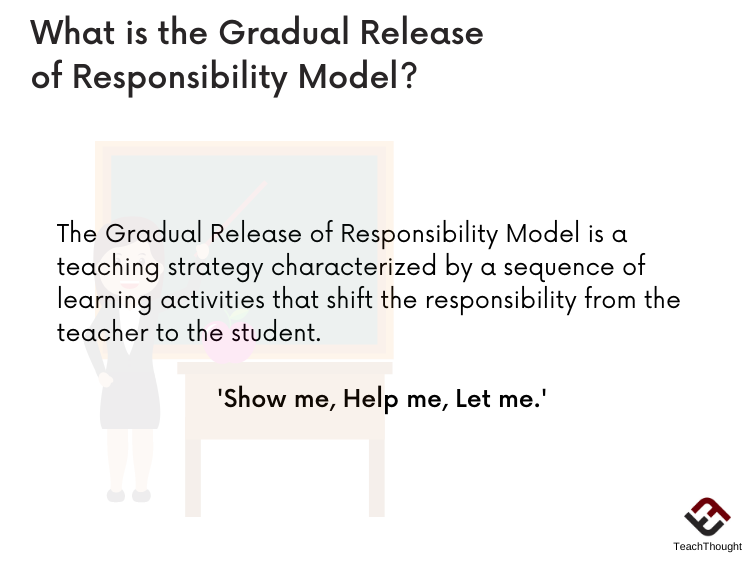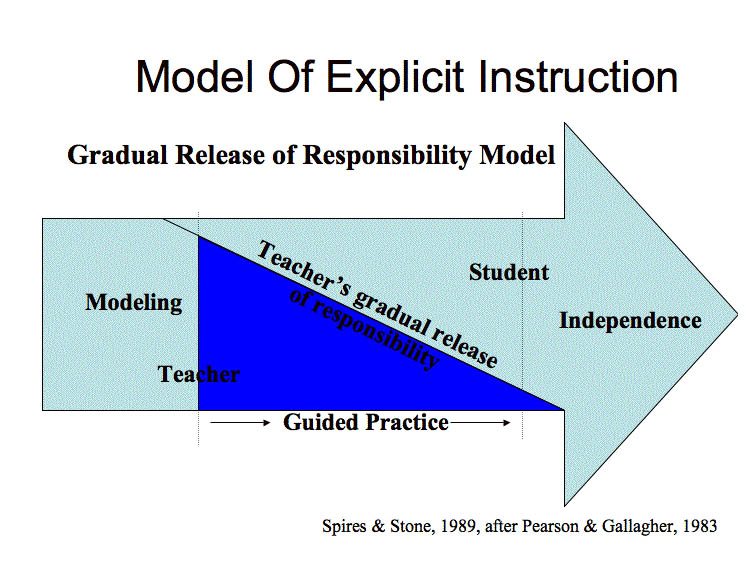
This post has been updated and republished
What Is The Gradual Release Of Responsibility Model?
by TeachThought Staff
What is the Gradual Release Of Responsibility Model?
The Gradual Release of Responsibility Model is a teaching strategy characterized by a sequence of learning activities that shift the responsibility from the teacher to the student. The goal of this approach is autonomy and efficacy on the part of the student–ideally, the ability to transfer understanding on their own.
Wikipedia offers that the “ideal result is a confident learner who accepts responsibility for their own learning and directs this learning through the cognitive processes involved, moving through the academic spectrum, to independent choice (personalized learning ). As Buehl (2005) stated, the GRR model “emphasizes instruction that mentors students into becoming capable thinkers and learners when handling the tasks with which they have not yet developed expertise.”
The Gradual Release Of Responsibility Model In 6 Words
Show me, help me, let me.
Within this short phrase lies several many of the pedagogical ‘best practices’ that simply work in learning, most fundamentally modeling (show me), scaffolding and support (help me), and transfer (let me–though it’s true you can ‘let a student’ without requiring transfer).
The gradual release of responsibility model is a key tenet of formal learning, from basketball courts to apprenticeships to academic classrooms. In short, show me, help me, let me implies a lot:

What The Gradual Release Of Responsibility Model Implies
1. That there is something new unmastered (and hopefully worth mastering)
2. That the learner is working within their ZPD–the work can be done with the support of a “More Knowledgeable Other” (show me)
3. That there is an ‘MKO’ available and attentive to the personalized learning needs of the learner (help me)
4. And crucially, that the goal is independent application (let me)
See also Sync Teaching For Learning On Screens
The graphic below is described by its authors as a model of explicit instruction–of straightforward pedagogy and teaching–and that’s true. But it’s also a powerful actuator for self-directed learning. Built-in to this idea is progress not towards mastery, but independence–and hopefully self-initiated transfer of understanding.
Do you find the gradual release of responsibility level more useful at the lesson, assessment, or unit level? Or all 3?
Using The Gradual Release Of Responsibility Model In The Classroom
The basic sequence is:
1. Direct Instruction
2. Guided Instruction
3. Collaborative Learning
4. Independent Practice
Note, this is a non-linear process. Students may–and often will need to–move back and forth between levels as they develop proficiency around a skill or concept. The gradual release of responsibility model in the classroom is probably something you use all the time without noticing it. For example:
Showing an example of a math theorem or textual analysis on the board or playing a visual example from a short YouTube video, then asking the students to try to do the same on their own. Coaches do it all the time on the field, showing techniques, then verbally guiding techniques, before releasing the players to try it on their own.
In the classroom, this model can help frame a unit–towards the beginning of the unit, there is a focus on exemplars and modeling, and towards the end a focus on individual performance.
It can work on a daily basis, too–a lesson or activity structured in a way that moves from teacher (or expert)-centered to student-centered.
It can also be used for assessment–give an example, remove some of that support in “part B,” and in “Part C they’re entirely on their own to show you what they understand.
Conclusion
The gradual release of responsibility model is one of the oldest ideas in learning, and sometimes, with all of the hubbub about the latest trends, tools, and world-beating ‘research-based strategies’ swimming around your head, it can help to get back to the basics of teaching and learning in 6 simple words.
Show me, help me, let me.
What Is The Gradual Release Of Responsibility Model? A Definition In 6 Words
